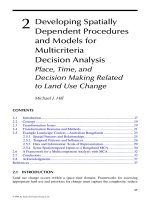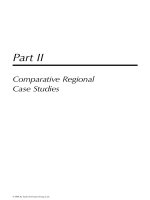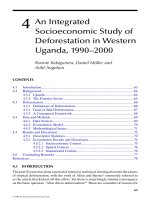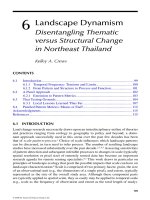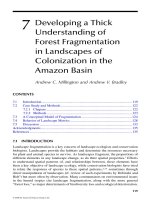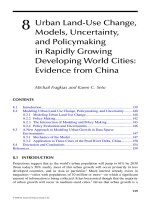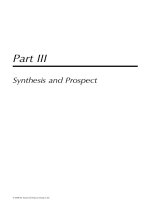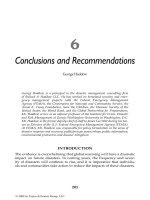Land Use Change: Science, Policy and Management - Chapter 6 pdf
Bạn đang xem bản rút gọn của tài liệu. Xem và tải ngay bản đầy đủ của tài liệu tại đây (537.82 KB, 20 trang )
99
6
Landscape Dynamism
Disentangling Thematic
versus Structural Change
in Northeast Thailand
Kelley A. Crews
CONTENTS
6.1 Introduction 99
6.1.1 Temporal Frequency: Tensions and Limits 100
6.1.2 From Pattern and Structure to Process and Function 101
6.2 A Panel Approach 102
6.2.1 Extension to Pattern Metrics 103
6.3 Thai Testing Grounds 104
6.3.1 Local Lessons Learned Thus Far 107
6.4 Paneled Pattern Metrics: Means or End? 112
Acknowledgments 115
References 115
6.1 INTRODUCTION
Land change research necessarily draws upon an interdisciplinary milieu of theories
and practices ranging from ecology to geography to policy and beyond; a domi-
nant approach successfully used in this arena over the past few decades has been
that of scale-pattern-process.
1
Choice of scale inuences which landscape patterns
canbediscerned,inturnusedtoinferprocess.Thenumberofresultinglandscape
studieshaveincreasedsubstantiallyoverthepastdecade.
2,3,4,5
Assessing sensitivities
of pattern detection and subsequent inferable processes to changes in scale (typically
spatialresolutionorpixelsize)ofremotelysenseddatahasbecomeanimportant
research agenda for remote sensing specialists.
6,7
This work draws in particular on
principles of landscape ecology that posit the possible impacts that scale can have on
landscape characterization.
8
Scaleiscomprisedoftwoprimaryfacets:grain,thesize
of an observational unit (e.g., the dimensions of a single pixel), and extent, typically
represented as the size of the overall study area. Although these component parts
are typically applied to spatial scale, they as easily may be applied to temporal scale
(e.g.,scaleasthefrequencyofobservationandextentasthetotallengthofstudy).
© 2008 by Taylor & Francis Group, LLC
100 Land Use Change: Science, Policy and Management
Implicit in these arguments is the separation of landscape conguration from land-
scape composition. In other words, the spatial association of different elements is as
importantastheoverallproportionofthelandscapeoccupiedbytheelements.Many
land use/land cover change (LULCC) applications, ranging from biology conserva
-
tion to hydrological assessments to land use planning, now routinely provide this
decoupled information.
4
This work reviews the successes, limitations, and possibili-
ties of enriching LULCC research with increased temporal grain or observational
frequency for extricating compositional or thematic change from conguration or
structural change. A case study from Northeast Thailand is used to illustrate this
paired approach, underscoring the need to further develop and rene this method in
ecosystems from elsewhere on the naturally or anthropogenically driven spectrum
andwithvaryingdegreesofspatiotemporalheterogeneity.
6.1.1 TEMPORAL FREQUENCY: TENSIONS AND LIMITS
Although most scale-pattern-process work has focused on spatial scale, temporal
scalehasnonethelessbeenexplicitlyincludedintheoreticaldiscussionsevenifseldom
analyzed.
4,9
Environmental remote sensing denes scale more broadly to include
spatial, temporal, spectral, radiometric, and directional scales.
10
Spatial and temporal
scale are particularly important when extracting thematic data for satellite image-
based change detection.
11
Spatial scale, both grain and extent, is regarded as a major
inuence on detection and denition of landscape patterns.
12,13,14
Temporal frequency,
or the time scale between available data acquisitions, is less studied in LULCC work,
inlargepartduetothelimitedavailabilityofhighqualityandhighresolutionmulti
-
temporal image sequences.
6,15,16
The temporal grain of imagery, though typically not
referred to as such, has been examined in environments where seasonality (whether
due to phenological, climatic, or anthropogenic changes) can interfere with assessment
of longer-term (read: interannual) LULCC.
17,18,19,20
ThetemporalextentofLULCC
projects typically defaults to either the early 1970s (concomitant with the 1972 launch
ofEarthResourceTechnologySatelliteorERTS1,laterrenamedLandsat1)or,ina
few cases, to a few decades earlier when military reconnaissance aerial photography
was available. The necessarily truncated temporal extent of these studies presents
problems in establishing baselines, a critical issue given the necessity of determining
what change has occurred and placing it in the appropriate historical context.
21,22
The
termspatiotemporalscaleordomainiswidelyusedwithintheLULCCmodeling
community, but this description may cause some confusion. The coinage of the term
presents an understandable commitment to consider how landscapes change across
time and space, though currently the state of the science tends to model spatial inter
-
actionsovertimeratherthanofferingapathfordigitallyrepresentingaspatiotemporal
scale as interactive rather than only combinatory.
Compounding the confusion is the dialogue concerning the use of the terms
landscape scale and landscape level. For geographers, the term landscape scale
connotes a certain size (spatial extent) of a study area—larger than a plot, smaller
thanacontinent,
4
andthetermlevelisoftenusedtodenotestudyacrossspatial
scales,
23
whether or not such work is spatially explicit (e.g., multilevel modeling
24
).
Formanyecologistswhotendtofocusrstonbioticcomponentsoflandscapes
© 2008 by Taylor & Francis Group, LLC
Landscape Dynamism 101
(e.g., populations and communities), the term landscape scale is nonsensical, since
dependinguponorganismsizeandrange,alandscapecanbeincrediblysmall
(considermicrobeslivinginasmallpuddle)oraslargeasaplanet.
25
This tension
manifests itself in incongruities and inconsistencies in the use of these terms (as
well as whether they are seen as interchangeable or not), a troublesome glitch for
LULCC scholars drawing upon ecology through the lens of landscape ecology.
1,26
For the purposes of discussing LULCC in this work, the term
landscape scale will
beusedtoconnotespatialandtemporalgrainandextentcommonlyusedinLULCC
work. The term
landscape level willbeusedtorefertoorganizationalortheoretical
constructswherethelandscapeliesonaspectrumoffunctionalunits,rangingfrom
patchestolandscapestometalandscapes.
27
Notetheaboveissuesrevolveprimarilyaroundspatialscale;rarelydoLULCC
practitioners mention a landscape scale when referring to a certain time, as opposed
to those studying longer-term landscapes (e.g., in geomorphology, sedimentology,
or palynology). Temporal matters are receiving more scholarly attention of late,
particularly in both empirical and process-based modeling efforts.
28
Landscapes
in temporally shallow LULCC studies are being increasingly considered as acting
upon their previous incarnations
22
and seen, therefore, as temporally contingent
uponthosepastdrivers.Pathdependenciescanandarebeingtrainedintomodel
-
ing scenarios, and presumably other temporal analogues of spatial concepts will
be operationalized (e.g., spatial neighborhood effects could be used as a model for
more sophisticated representations of path dependency via temporal neighborhood
effects). In spatial neighborhood effects, it is understood that the precise location
of the neighbor relative to the area of interest is often unimportant as long as that
neighbor is within a certain thresholded distance. So while analysis may take place
inaspatiallyexplicitenvironment,conditionsorrulescanbewrittentoloosenthat
explicitness and query, for example, for neighbors within a certain spatial distance
(withoutregardtothatdistance),withoutregardtodirection.Theparallelintemporal
studies would be to relax the assertion of temporal explicitness such that it may not
matter when a particular preceding event happened, only that it did happen or how
often it happened. Although temporal modeling is fairly straightforward in terms
ofassessingcausality(giventhepresumptionoflineartimemovingonlyforward),
thechallengeremainstosortoutfrommyriadperiodicitiesoflandscapedriversand
change, which are important enough in any given landscape, and how then to best
dene a temporal landscape scale.
6.1.2 FROM PATTERN AND STRUCTURE TO PROCESS AND FUNCTION
Several decades of LULCC research have shown that understanding landscape
change requires detecting changes in both composition and conguration.
6,8
Typi-
cally these components are assessed sequentially: rst, a landscape is classied into
athematiclanduse/landcover(LULC)schemeforatleasttwotimes;second,the
conguration of each of those classied landscapes are quantied through some type
of pattern assessment (often pattern metrics
29
); and third, postclassication change
detection is performed on those thematic classications to produce thematic change
map(s).
30
Although the process usually stops there, some researchers have also then
© 2008 by Taylor & Francis Group, LLC
102 Land Use Change: Science, Policy and Management
quantied the conguration of the change map(s) with pattern metrics as well,
11
though concerns of error propagation have limited this approach.
31
The importance
of ascertaining spatial structure (and changes in said spatial structure) stems from
landscape ecology, where spatial conguration facilitates and mitigates the ow of
energy and materials across the landscape.
8
That is, the landscape interactions that
both cause and are manifested as landscape change necessarily occur in space, and
locationmatters.Thatisnottosayallchangesoccurasdiffusivemovementssince,
dependinguponthevectorofmovement,energyormaterialsmaybeimpartedby
jumpingorpercolatingacrossthelandscape.
4
Dening the temporal nature of spatial
structurewillassistintakingthesemeasurementsandconvertingthescale-pattern
into process.
Processcanbedenedintwoprimaryways.Therstwillbereferredtoas
dynamics,anditisamechanisticconceptrootedinpatternsofchange,growth,
and activity; this denition is embraced by the Geographic Information Science
community(GISc)studyinglandscapedynamics,andtsthenecessarilypiecemeal
fashionbywhichLULCisextracted,studied,andmodeled.Thesecondtypeof
processwillbereferredtoasdynamism,whichisamoregestalticconceptthat
involvescontinuouschange,growth,oractivity;thisdenitioncomesfromthe
ecology community (particularly landscape ecology) and ts the more continual
natureoftheprocessesstudiedbyecologists,whetherparticulartolandscapestudies
or not.
32
Thenuanceofthedifferenceinthesetwoapproachesisslight,buttheimpli-
cations are easily observable in the varying operationalization of both epistemology
and methodology now evidenced in landscape change studies from these two com-
munities. Here, panel analysis of LULC and paneled pattern metrics are offered as
onemethodofbridgingthisgap,suggestingthatLULCCscholarsshifttowardan
approach of understanding landscape dynamism via improved assessment of LULCC
dynamics.
11,27
Thatis,improveddescriptionofmechanicsshouldleadtoimproved
explanation and prediction of process and, perhaps, function.
6.2 A PANEL APPROACH
Panel analysis simply refers to a longitudinal method whereby units of analysis are
heldconstant.Longusedinpsychologyandsociology,panelorlongitudinalanalysis
followedthesamesubjectsovertime(asopposedtoacensusorcross-sectional
approach, where different subjects are evaluated in each observation period). Tech-
nically, all from-to remote sensing-based change detection is panel analysis, since
eachpixelorinstantaneouseldofview(IFOV)isfollowedindividuallythrough
time, presuming accurate geometric rectication.
30
However, from-to change detec-
tionusuallyisperformedonpairsofimages,whereaspanelanalysis(inLULCC)
isnowusedtorefertoatimeseriesofthreeormoreclassications.
33,34,35
In panel
analysis, pixel histories or trajectories are constructed that maintain the entire tem-
poral pattern of LULC in order to reveal greater information about process(es) behind
observable patterns. For example, consider a humid tropical area classied only into
forest(F)andnonforest(N)andobservedovertwodecadeseveryotheryear.With
panel analysis, trajectories that might be calculated would include those suggest-
ing semipermanent deforestation (e.g., F-F-F-F-N-N-N-N-N-N-N), deforestation and
© 2008 by Taylor & Francis Group, LLC
Landscape Dynamism 103
successional regrowth (e.g., F-F-F-F-N-N-N-N-N-F-F), afforestation or reforestation
(e.g., N-N-N-N-N-N-N-F-F-F-F), silviculture of fast growing tree species (e.g.,
F-N-N-N-F-N-N-N-F-N-N-N), or fallow cycling (e.g., N-F-F-F-F-F-N-F-F-F-F-F-N).
Withtraditionalfrom-tochangedetectionoftherstandlastyears,thosetrajectories
wouldhavehadtheirchangecharacterizedasfollows:semipermanentdeforestation
with F-N would still be called deforestation (correct); deforestation and successional
regrowth with F-F would be called stable or permanent forest (incorrect); afforesta
-
tion or reforestation with N-F would still be called as such (correct); silviculture with
F-N would be called deforestation (incorrect), and fallow cycling with N-N would
be called permanent nonforest (incorrect). Ultimately the panel approach to LULCC
doesnothingtoimproveattributionofclassesthatarestableovertime,andlittleto
improve attribution of classes whose change is unidirectional. But landscape compo
-
nents that undergo very quick change, cycle through multiple stages, switch between
two or more classes frequently, or are inuenced by relatively short-term phenomena
(e.g., seasonality) are open to better multitemporal characterization. That is, panel
analysis improves our ability to detect the kinds of change that LULCC research is
largelydesignedtocapture,model,andmanage;bycorollary,traditionalfrom-to
change detection is biased toward detecting stable, slow-changing, or unidirection
-
ally changing classes. As the number of classications in the time series increases,
quiteobviouslytheabilitytodetectgreaternuancedormorequicklyswitching
change increases. The question for LULCC projects then is how many images are
enough? The textbook answer is that it depends upon the time footprint of landscape
processes on the landscape (e.g., humid tropical forests reach successional canopy
closuremorequicklythantheaveragetemperateforest);thepracticalansweristhat
itdependsonhowmanyqualityimagesareavailableinanareagivenatmospheric
interference, sensor problems, cost of acquisition, and access to archives, to name
onlyafewoftheproblemsfacingtheLULCCcommunity.
6.2.1 EXTENSION TO PATTERN METRICS
Though pattern metric analysis is typically output as statistics at the patch, class, and
landscape levels, some packages such as Fragstats
29
allow for outputting patch-based
imageswherebyeachpatch(fromwhichallpatch,class,andlandscapestatisticsare
generated) is mapped with a unique identier or object (whether computed in raster
or vector, bit depth limitations notwithstanding). The goal of paneled pattern metric
analysis is to assess the changing structure of landscape patches without regard to
thematicclass.Thatis,inbuildingpatternmetricpanelsweexplicitlychooseto
examine the nature of, for example, fragmentation without regard to whether it is
an urban area, forested expanse, or agricultural eld that is being fragmented. By
doing so, the explicit contribution of conguration as opposed to composition can
be tested, assessed, and modeled. Current research at this point has focused on the
formulation and sensitivity analyses of paneled pattern metrics, and this method
requires further testing in other ecosystems and landscapes with differing levels of
spatial, temporal, and spatiotemporal heterogeneity. In cases where the robustness
and sensitivity of the paneled pattern metric method is validated, the next step is to
© 2008 by Taylor & Francis Group, LLC
104 Land Use Change: Science, Policy and Management
notonlytesttheseparateimpactsofcompositionandconguration,butalsotheir
interaction and confounding as well.
Theconstructionofpaneledpatternmetricsfollowslogicallyfrompanelanalysis,
andtheentirepanelmethodispresentedinFigure6.1.First,atimeseriesofimagery
is categorized into thematic classications; a minimum of four temporal observa
-
tionsissuggested,thoughifpatchboundariescanbederived,generated,orfound
elsewhere, three classications may sufce (in absence of preexisting patch delinea-
tions,abaselineyearofthetimeseriesisused,requiringthreefurtherclassications
for moving beyond traditional two-image change detection). From these classica-
tions, a panel LULC is created as depicted and as described above. Additionally,
pattern metric analysis is run on each classication, outputting both statistics and
patch images for all observations for each metric of interest. For purposes of this dis-
cussion, presume the metric of interest is the interspersion/juxtaposition index (IJI).
Change images between consecutive pairs of patch images are calculated and may
initiallybeleftasoatoutputbutmusteventuallybebinnedintocategoriesofchange
(e.g.,increaseby>20%,increaseby10%to20%,increaseby5%to10%,changeby
± 5%, decrease by 5% to 10%, decrease by 10% to 20%, decrease by > 20%). Once
binned appropriately, the change between each set of IJI metric images is stacked to
build a trajectory of change at the patch level and then exported to individual pixels
and built back to a nal mapped product of paneled pattern metrics output at the
patch level.
11
Theprocessisrepeatedforeachmetricofinterest,witheachmetric
binned according to appropriate hypothesized or observed thresholds or ip points.
Currently bounded or constrained metrics have been tested in order to limit the
subjectivity involved in categorization of the metric output. That is, metrics such as
IJI, double log fractal dimension, and percentage landscape all—as operationalized
in Fragstats and other pattern metric programs—have theoretical bounds where both
the upper and lower limits are known. Unbounded or unconstrained metrics (e.g.,
mean patch size, shown in Figure 6.1 for contrast) present greater subjectivity in cat-
egorization since there is no theoretical limit for these metrics (though in any given
landscape and with any given classication scheme an empirical limit obviously
exists). As currently written, the paneled pattern metric algorithm presumes equal
intervalsbetweentimestepssincetheoriginaltimeseriesusedfortestingmet
thoseconditions;modicationtoaccountfordifferingtimelagsiseasilydoneviaa
weighting mechanism once categorization thresholds (number and placement) have
beendetermined.Assuch,themethodissuitableforbothinterannualandintra-
annual analyses.
6.3 THAI TESTING GROUNDS
TheconcernoverinterannualandintraannualLULCCstemsfrombuildingthis
approach in an environment with strong phenological, climatic, and anthropogenic
seasonal pulses, rendering assessing longer-term LULCC problematic when anything
but anniversary date imagery was used for deriving LULC information. Northeast
Thailand is home to a region known as Isaan, where the former Nang Rong district
resides (due to growth and redistricting this area now includes not only the Nang Rong
districtbutalsoNonSuwan—denotedonsomemapsasNonguWuan,Chamni,and
© 2008 by Taylor & Francis Group, LLC
Landscape Dynamism 105
IJI = 14.2
MPS = 8.1
IJI = 17.9
MPS = 4.7
IJI = 23.7
MPS = 2.2
IJI = 19.2
MPS = 3.1
(2)
(2a)
(2b)
(3a)
(3)
(1)
FIGURE 6.1 (See color insert following p. 132.) The panel process, conducted at
both the pixel and patch levels: (1) four multispectral satellite images are each catego-
rizedintoathematicLULCclassication;(2)patternmetricsarerunoneachofthefour
LULC classications, each producing a set of patch, class, and landscape statistics (here the
interspersion/juxtapositionindex[IJI]andmeanpatchsize[MPS]areshown)aswellasan
output image of the delineated patches; (2a) pattern metric output for each of the four times
is used to calculate three piecemeal change maps for each pattern metric and each consecu-
tive pair of images (e.g., showing uctuations in IJI or MPS between two time periods) as
per Crews-Meyer
11,27
;(2b)threepatternchangemapsarestackedintoonepanelofallstruc-
turalchangeforeachgivenmetric(e.g.,showinguctuationinIJIorMPSthroughalltime
periods) as per Crews-Meyer
11,27
;(3)threethematicchangemapsarecreatedforeachofthe
timeperiodsrepresentedbythefourclassications;(3a)thethreethematicchangemapsare
stackedtorepresentthefullrecordofallthematicchangeacrossthefourclassicationsas
per Crews-Meyer.
3
© 2008 by Taylor & Francis Group, LLC
106 Land Use Change: Science, Policy and Management
ChalermPrakeat;thisworkwastestedprimarilyincurrentdayNangRongandNon
Suwan).SituatedinbothBuriramProvinceandthenorth-owing MekongRiverDelta
system, the area is the poorest area of a poor country
36,37
and dominated culturally,
ecologically, and nancially by a strong monsoonal pulse, poor soils,
38
and concomi-
tant lowland wet rice production.
39
Villagers typically live in a nuclear settlement
pattern (see Figure 6.2), with residences located in lowland wooded remnants and rice
eldsradiatingoutinmostdirectionsforthetypical2to5kmdailywalktoelds.
40,41
Though this area was not inuenced by the Green Revolution, agriculture has driven
theconversionofthelandscapeinitiallyopenedbymilitaryroadbuildingeffortsand
facilitatedbythegradualbuildingtowardamarketeconomy.
37
Wetricereplaced
savannainthelowlands,whiledrought-deciduous cropssuchascassavaandsugar
-
cane followed the 1970s factor price increase into the upland dry dipterocarp forests.
Followingacurrencycollapseinthelate1990s,manyyoungadultswhotypically
migrated to Bangkok or the eastern seaboard for labor returned to the district at the
sametimethegovernmentunderwentanewwaveofdecentralizationacrossfederal
to local levels.
40
An increasingly dense network of road building and water impound-
ments,
33
combined with poor environmental management (e.g., lack of draining rice
irrigation waters increases soil salinity), has compounded the intensication cycle
seeninpartsofSoutheastAsiaandelsewhere.Althoughtheselonger-termdynamics
havebeendocumentedthroughanextensivehouseholdandcommunitysurveyseries
FIGURE 6.2 Typical nuclear village settlement as seen in 1:50,000 scale panchromatic
aerial photo from 1994, with approximate settlement boundary indicated. Note remnant
forestpatchesusedforshaderelief,andricepaddysurroundingvillageradially.
© 2008 by Taylor & Francis Group, LLC
Landscape Dynamism 107
as well as remote sensing and geographical information systems (GIS) analyses, the
seasonal pulses also detected (when imagery, eldwork, and weather permit) can cause
detectable landscape change as large in magnitude (if not ecological importance) as
two decades of interannual change.
18,19
The presence of a monsoonally driven climate
adds to the logistical problems of obtaining cloud-free imagery for deriving LULC
information.However,adeeptimeserieshasbeenestablishedaspartofalarger
project and has proven more than adequate for testing the panel LULC and paneled
pattern metric methods.
41,42
Figure 6.3 illustrates interannual trends in LULCC in
thelargerstudyareaovera25-yearperiod;easilydiscerniblearetherapiddeclinein
morehighlyvegetatedLULC(particularlyintheuplandsouthwesternsection)and
the expansion of rice into the lowland savannas.
6.3.1 LOCAL LESSONS LEARNED THUS FAR
Figure 6.4 illustrates a stylized representation of four LULC classes and their compo-
sitionalchangeovertimeasobservedand/orreportedelsewhere.Figure6.4ashows
the interannual or longer-term change in forest (primarily upland dry dipterocarp
andgalleryremnantforestsalongripariancorridors),savanna(primarilylowland
graminoids with some standing trees), wet rice agriculture, and other agriculture
(uplandordroughtdeciduouscropsandcashcrops,includingcassava,kenaf,jute,
and sugarcane).
33
These “real” changes can be contrasted with the stylized represen-
tationofintraannualchangeinagivenyearduetopreviouslymentionedseasonality
showninFigure6.4b.ThisgraphisorderedbytheThaiwateryearthatrunsApril1
throughMarch31,withearlymonsoonalshowers(knownasmangorains)commenc
-
inginMayandfollowedbyseveralmonthsofheavyprecipitationthatisextremely
(a) (b) (c)
FIGURE 6.3 (See color insert following p. 132.) (a) LULC in the greater study area in
the1972/1973wateryear;(b)1985;and(c)1997.
Background
Higher Density Forest
Lower Density Forest
Savanna
Bare Soil
Rice Agriculture
Mixed Agriculture
Cash Crop Agriculture
Water
© 2008 by Taylor & Francis Group, LLC
108 Land Use Change: Science, Policy and Management
variable in both time and space; rice is typically harvested in late November or
December, with elds burned usually in January and the driest months ending the
water year. These “changes” are part real (e.g., phenological change with agricultural
crops or deciduous cycles) and in part artifact (e.g., green-up from showers without
actual canopy or biomass change).
TypicalforestchangesinthispartofnortheastThailandrepresentafamiliar
story: from the 1970s through the 1990s, forests generally declined (as did savannas)
duetoagriculturalextensication.Anearlyriseinotheragricultureintheuplandsat
theexpenseofforests(nowrelegatedtoextremelythinripariancorridorsandsmall
remnantsatopthemostuplandsitesonvolcanicsoils)wasfollowedbyasharprisein
wet rice agriculture in the lowland areas. Village settlement and expansion occur in
these lowland areas as well, although these areas account for little change in terms of
FIGURE 6.4 (a)StylizedLULCtrendsobservedand/orreportedinNortheastThailand
from the 1970s to late 1990s (annual change, holding seasonality constant). (b) The same
trendswithinagiventypicalyear(intraannual).
Time (Interannual)
Percent Landscape
50
45
40
35
30
25
20
15
10
5
0
Forest
Savanna
Rice Ag.
Other Ag.
Forest
Savanna
Rice Ag.
Other Ag.
0
10
20
30
40
50
60
Time (Intraannual)
Percent Landscape
(a)
(b)
© 2008 by Taylor & Francis Group, LLC
Landscape Dynamism 109
spatial footprint. Some tradeoff is suggested between wet rice agriculture and other
agricultureindryversuswetyears,likelyexplainedbyterraceposition(notanthro
-
pogenic rice terraces, but uvial terraces or middle elevation grounds that do not
ood each year) since rice may be planted at slightly higher elevations in wet years
with cash crops occupying those areas in dryer years. Overall the interannual com
-
positional changes exhibit some sharp increases or decreases over time but represent
fairly stable trajectories (note this graph is overall composition; a per pixel compari
-
son would represent much more switching among classes, and a greater classication
scheme depth or move away from an anniversary date/stylized representation would
showmuchgreateructuationaswell).
The intraannual representation depicts much more marked uctuations in com
-
position of these four LULC classes. Forests appear to have greater cover due to
phenological changes (green-up from rains) and lesser cover during deciduous events.
Riceagriculturechangesdramaticallywithcropcalendarandrelatedmonsoonal
timing, as rice paddy move from ooded to planted to owering to harvest to burn
-
ingtobarren;sotoodolandsofotheragriculturechange,althoughtoalesserextent
than rice owing to the drought resistant nature of some of these crops. Savanna
coverappearstochangedramaticallyaswellanddoessoinresponsenotonlyto
green-upofgrassesbutmoreovertoallagriculturallandsspectrallymixingwith
grassy savannas during dryer periods. The magnitude of intraannual change com
-
paredtointerannualchangeunderscorestheneedforanniversarydateimagery,but
also for understanding the process implications of the periodicities of different types
ofchange.Withoutaphysicalprocessguideintermsofthecriticalityofacertain
loss or gain in one cover type over another, perhaps LULCC scholars can at least
bracket interannual change in the context of seasonal dynamics typically observed to
understandwhenthelandscapehaschangedbeyondits“natural”resilience.
9,43
Figure 6.5 moves to the consideration of structural change by showing two typi-
cal metric trajectories for interannual changes, again from the 1970s to the 1990s.
Figure 6.5a graphs the IJI for the same four classes, and from this illustration the
landscape narrative quickly becomes apparent. A mapped view of this for a subset of
the study area is also presented in Figure 6.6, as typically in interpretation both patch-
derived statistics (e.g., Figure 6.5) and maps of change in conguration (Figure 6.6)
are used. Here, both forest cover and wet rice agriculture experienced a sharp increase
in IJI followed by a sharp decrease, indicating increases in interspersion followed
by decreases. Taken together, these two trends exhibit evidence of an important
ecological change in the landscape, and one that when mapped shows elevational
differences.Forestedareas,notablyinthesouthwestinNonSuwandistrict,had
been the matrix or dominant class in upland areas in the early 1970s, but became
increasingly fragmented and interspersed as other agriculture was introduced. By
the early 1990s, the forest had been desiccated to little but remnant patches, and
although still interspersed with other LULC types, these forested patches were so
small that the metric plummets as less and less forest edge remains to neighbor other
LULCtypes.Asimilartrendofriceagricultureoccursinthelowlandareasbutfor
theoppositereason:riceexperiencesasharpincreaseininterspersionasitbecame
moreandmorewidespread,untilbythelate1980sitbecamesoubiquitousthatits
spatial cohesion results in lower IJI scores. Smaller changes in other agriculture IJI
© 2008 by Taylor & Francis Group, LLC
110 Land Use Change: Science, Policy and Management
support the hypothesis that not only the composition but also the conguration of
thisclasschangesinthemiddleelevationareas,whileexperiencingsomechangesin
upland areas at the expenses of forested lands. Savanna, particularly in the eastern
portion of the area, becomes increasingly interspersed with wet rice agriculture,
particularly in areas more proximate to the primary river channels (i.e., that ood
themostfrequently).Thislandscapenarrativeisbolsteredbyinterestinglyparallel
changes in mean patch size (MPS) (Figure 6.5b), where typical agriculture patches
(regardless of type or topographic position) increase as agriculture overwhelms the
landscapeatthespatialexpenseofbothforestandsavanna.
Movingbeyondthecombinedchangesincompositionandcongurationtocon-
guration only
11,27
illustrates trends in structure related to topography and acces-
sibilitynotdetectableintheaboveefforts.First,wavesoffragmentationareeasily
discernibleinthesouthwesternoruplandareasaspeopleliterallymovedupthehills
fromsurroundinglow-lyingareas.Typicallyuplandcropsarelesslaborintensive,
Interspersion / Juxtaposition Index
30
25
20
15
10
9
8
7
6
5
4
3
2
1
0
(a)
(b)
Mean Patch Size (Hectares)
Time (Interannual)
Time (Interannual)
Forest
Savanna
Rice Ag.
Other Ag.
Forest
Savanna
Rice Ag.
Other Ag.
FIGURE 6.5 (a) Stylized LULC pattern metric change for the interspersion/juxtaposition
index(IJI)observedand/orreportedinnortheastThailandfromthe1970stolate1990s
(annual change, holding seasonality constant). (b) Metric output for mean patch size (MPS)
for the same time and location.
© 2008 by Taylor & Francis Group, LLC
Landscape Dynamism 111
(a)
(b)
(c)
FIGURE 6.6 (See color insert following p. 132.) (a) The change in conguration
from 1972/1973 to 1975/1976, revealing that the entire subset area has experienced
a greater than 10% increase in interspersion/juxtaposition index (IJI) scores (due to
increased fragmentation and concomitant interdigitation). Note that most of the area
experienced the same type of change. (b) Illustration of a different trend between
1975/1976 and 1979, whereby increases, decreases, and relative stability in IJI vary
spatially. More upland areas (most central in the subset) experienced a consolida-
tion on the landscape, while peripheral areas remain relatively stable in terms of
conguration with notable exceptions on the southeastern perimeter. (c) Illustration
of the continued spatial heterogeneity in IJI, with lowland/peripheral areas undergo-
ing continued fragmentation, while the less accessible, upland areas appear to have
leveled off in terms of larger-scale fragmentation or consolidation but continue to
experience small pockets of fragmentation throughout.
© 2008 by Taylor & Francis Group, LLC
112 Land Use Change: Science, Policy and Management
anddonotrequireproximitytothenuclearvillagesettlementsthatricepaddydo.
Thus, when factor prices for cassava increased in response to European demand for
cattlefeed,itwasrelativelyeasyforlowlandvillagerstoplantuplandareasnotpre-
viously claimed given that they had been seen as undesirable for rice or residence,
given their (uphill) distance to rivers. Interestingly, the southern edge of this area
didnotseeanadvancementofagricultureasdidtheotherareas,possiblyduetothat
side’s proximity to the Khmer (Cambodian) border and related history of military
violence and mine elds.
40
Inthelowlandareas,thetrendsovertimerespondmore
to accessibility to riparian corridors and thus assurance of yearly ooding for the
best rice paddy lands.
27
Structurally, though, the upland and lowland areas were very
similar, despite the different dominant LULC types and various drivers of LULCC.
First, in terms of IJI, the core areas (either most central in the upland areas or closest
to riparian channels) exhibited the greatest possible uctuation in IJI across time.
Regardless of LULC type, these areas experienced increases, decreases, and periodic
episodesofstabilityinIJIoverthe1970sand1980s.Sowhilethecovertypesmay
have been relatively slow to change over time, by comparison the structure, speci
-
cally the interspersion of LULC classes, was constantly changing and changing in
differentways.Thatis,notonlywasthererstorderchangebutalsosecondorder
change. The areas proximate to these core regions also experience fairly dramatic
structural change as reected by IJI, although slightly more consistent in the second
order(roughlytwoperiodsofincreasingIJIwithoneperiodofdecrease).Interms
of percentage landscape (PCT), the similarities in upland versus lowland areas were
less pronounced. The core upland areas (the least accessible) saw early decreases
in PCT, followed by increases and subsequent decreases, similar to the trends in
LULCC and LULC pattern change discussed earlier. The regions proximate to the
uplandcorebutmoreaccessible(lowerelevations)showedtwoperiodsofdecrease
aswell,althoughtheincreaseinPCTcameatslightlydifferenttimes(anotable
exception was the southernmost region mentioned earlier, which was structurally
stable in the dynamic sense in that it experienced a decrease in PCT through all
observations). Lowland areas, in contrast, nearly uniformly displayed the decrease-
increase-decrease pattern for PCT, despite observed stability in LULC composition,
suggestingthateveninthefaceofrelativelystableLULCCthestructuraldynamism
oftheareawasin“constantuctuation.”
6.4 PANELED PATTERN METRICS: MEANS OR END?
The subjectivity of the panel approach, and particularly the paneled pattern metric
method, presents signicant challenges and merits testing in ecosystems with dif-
ferent levels of human impact and landscape heterogeneity (across time and space).
Aparticularconcernisthedelineationofpatchboundaries;whentestingexisting
patches (be they forest refugia, control plots, or cadastre-dened parcels of land), the
boundariestouseinanalysisareclear.Butotherwise,boundariesareconstructed
from a year of the imagery, and the determination of the base year impacts what
trends are possible to detect and in what direction. By testing the sensitivity and
robustnessofresultstochangesinthebaseyear,researchershaveinpaneledpattern
metrics a potential tool for creating ecologically meaningful units of analysis that
© 2008 by Taylor & Francis Group, LLC
Landscape Dynamism 113
t within a hierarchical (nested or non-nested) framework suitable for drawing upon
theories of landscape ecology and hierarchical patch dynamics.
4,8,9,44
With increas-
inggraininthetimeseries(greaternumberofobservationsorimages),thepossible
bias in baseline determination should drop. However, traditional notions of accuracy
assessment calculation posit that as the number of temporal observations increases,
the amount of accuracy assessment data needed increases at an increasing rate
31
and
the likelihood of an acceptable cumulative product decreases sharply. If 10 images
with 95% accuracy were used, the traditional manner of representing change accuracy
would mean that, at best, the 10-image change product would have an accuracy of
just under 60% (0.95
10
): an accuracy level hardly worth pursuing. And yet it appears
that these multi-input products offer the most promise for extracting process. Perhaps
a new framework for considering how to think about change and accuracy is needed.
From physics, Grifths’s
45
consistent history approach holds promise as a metaphor
for accuracy, where the greater the observations, the less important any given error
in any given observation is, since the pattern is indicative of larger temporal relation
-
shipsatworkandnotaproductofanyonesingulareventormistakenpixelclassica
-
tion. Rectifying this line of reasoning with disturbance and (dis)equilibrium theory
presentsachallengingbutfruitfulavenueofepistemologicalandmethodological
reasoning, especially given continued sensor systems failures requiring analysts
tobuildtimeseriesfrommultiplesensorplatformsandthuspossiblyintroducing
artifacts into classications when compared across time.
30,31
Integratingnotonlyclassicationsderivedfrommorethanonesensorsystem
butotherkindsofproductspresentsanotherfrontierofLULCCwork.Duetofactors
varyingfromcosttoclimaticconditions,establishingsufcienttemporalgrainor
frequency challenges many research teams; moreover, the temporal extent of most
LULCC work lacks the historical depth necessary to test, assess, or account for
landscapeimpactsoccurringoverlongertimeframesorinthemoredistantpast:
geomorphological change, species evolution, past civilization land uses, and climatic
changeresearchallofferevidencethattheforcesatworkonlandscapesthousands
to hundreds of thousands of years ago still impact landscapes and landscape compo
-
nents today (Figure 6.7).
22
LinkingofmappedproductstorecentLULCclassica-
tions has been done infrequently to extend a time series, but the real challenge lies in
linkingnon–wall-to-wallornonspatiallyexplicitproductstotoday’sdigitalproducts.
Travel journals, agricultural taxation records, and artwork offer rare glimpses into
unchartered temporal extents of landscapes of long ago,
22
even in those lacking in
spatial extent and explicitness.
Thepanelmethodgenerallyis,perhapsobviously,ofmostuseindatasets
witharichtimeseries.AsdigitalarchivesofLULCandLULCCbecomemore
widely available, this approach can be further tested in differently impacted social
and environmental landscapes. Panel analysis has most commonly been applied to
information extracted from optical sensor systems, but it could be extended to other
imagery sources. Panel analysis offers particular appeal for landscapes with temporal
heterogeneity. Paneled pattern metrics, more specically, offer the greatest potential
insightwhenlandscapecoverchangeappearstobeseparablefromchangesinland
-
scape conguration. For example, in areas of shifting or swidden (an area cleared for
temporary cultivation by cutting and burning the vegetation) cultivation, the amount
© 2008 by Taylor & Francis Group, LLC
114 Land Use Change: Science, Policy and Management
(b) (c)
(a)
(d)
FIGURE 6.7 (a) Seasonality impacts this landscape in several ways. Here, rice stubble is
atypical“winter”ordryseasonlandscapecomponent.Hazeinbackgroundissmokefrom
traditional burning of the rice elds to boost nutrients in these degraded soils. (b) Cash crop
agriculturetendstooccurintopographicregionsnotsuitableforannualriceproduction.
Shown are sugarcane (for market) and eucalyptus (typically for local building supplies, eld
borders, or soil stability). (c) Typical recently improved (elevated) road with rice agriculture
in background. “Borrow pits” provide road elevation materials and are often subsequently
usedassmallwaterimpoundmentsforirrigation.(d)Whilemostwaterimpoundmentsin
theareaaresmallinspatialextent,theimpactofthenetworkofsuchimpoundmentsis
critical in population-environment impacts. Water impoundments, while used for irrigation
and ood control throughout many elds, are typically ringed by a small fringe of water-
demanding crops for household consumption, such as watermelon and bananas.
© 2008 by Taylor & Francis Group, LLC
Landscape Dynamism 115
of lands under any particular use may change very little between observations; but
thecongurationcouldstillbeuctuating,particularlyunderlocalizedmanagement
strategies. Landscapes undergoing even drastic LULCC may in fact be structurally
stable when wholesale replacement of classes occurs. Landscapes undergoing both
compositional and congurational change present the most complex situation for
landscape assessment, and disentangling these types of landscape change is critical
forextractingabetterunderstandingofprocessandfunctionfrompattern.Tempo-
rally, landscapes with heterogeneous change (different rates of change over different
periods) would benet more from the general pattern approach than those with
consistent temporal processes, but proper extraction of these patterns presumes an
adequately rich time series.
The panel method generally, as used here and elsewhere,
34
offers LULCC
researchers one way of sliding closer to process on the pattern-process spectrum.
Assessing dynamism (continuous change) from dynamics (changes and drivers
assessed via snapshots in time) remains a critical area of concentration for the
LULCC community. The paneled pattern metric approach provides a means for
exploringstrongerlinkagestoprocessandfunctionfrompatternsofLULCand
LULCC. Moreover, paneled pattern metrics constitute an explicit test of the value
of landscape ecology to LULCC work by exploring the relative contributions and
interactionsoflandscapecompositionandconguration.Theimplementationofthis
toolis,currently,pronetosubjectivity.Althoughpatternmetricshavebeenfound
to reveal critical differences in landscapes, rarely are they explicitly and quantita-
tively linked to human or biophysical processes. As such, determining appropri-
ate thresholds for categorization of constrained or unconstrained metrics remains
criticaltodobutdifculttojustify.Aswiththeintroductionofvegetationindices
several decades ago, a statistical correlation may convince some of the utility of an
approach, but ultimately it is the empirical and quantitative tie to process that con-
vincespractitionersoftheapproach’sworth.Thepursuitofthatlinkageisaripearea
for research of ecologically and biophysically grounded LULCC teams. It may be
that the process linkage between paneled pattern metrics and landscape processes is
neverdiscoveredorveried,oreventhatitisrejectedanddisproven.Butuntilsuch
a time, requiring a process linkage may be premature, when the greatest promise
of paneled pattern metrics may lie in application of a data mining approach to rst
uncover critical thresholds or ip points of LULCC, and then bring to bear theories
and methods for eshing out the processes at work.
ACKNOWLEDGMENTS
Iamgratefultothefollowingforsupportofthiswork:CarolinaPopulationCenter
and Department of Geography, University of North Carolina; Sigma Xi Scientic
Research Society; and Mahidol University, Thailand.
REFERENCES
1. Walsh, S. J., and Crews-Meyer, K. A. Linking People, Place, and Policy: A GIScience
Approach.KluwerAcademicPublishers,Boston,2002.
© 2008 by Taylor & Francis Group, LLC
116 Land Use Change: Science, Policy and Management
2. Meyer, W. B., and Turner, B. L., II, eds. Changes in Land Use and Land Cover:
A Global Perspective. Cambridge University Press, Cambridge, 1994.
3. Liverman,D.etal.
People and Pixels: Linking Remote Sensing and Social Science.
NationalAcademyPress,Washington,D.C.,1998.
4. Turner, M. G., Gardner, R. H., and O’Neill, R. V.
Landscape Ecology in Theory and
Practice: Pattern and Process. Springer, New York, 2001.
5. National Research Council.
Population, Land Use, and Environment: Research Directions.
Panel on New Research on Population and the Environment. Entwisle, B., and Stern, P. C.,
eds.,CommitteeontheHumanDimensionsofGlobalChange,DivisionoftheBehavioral
and Social Sciences and Education. National Academies Press, Washington, D.C., 2005.
6. Frohn, R. C.
Remote Sensing for Landscape Ecology: New Metric Indicators for
Monitoring, Modeling, and Assessment of Ecosystems. Lewis Publishers, Boca Raton,
Fla., 1998.
7. Rindfuss, R. R. et al. Developing a science of land change: Challenges and methodolog
-
ical issues.
Proceedings of the National Academy of Science 101(39), 13976–13981,
2004.
8. Forman,R.T.T.
Land Mosaics: The Ecology of Landscapes and Regions.Cambridge
University Press, Cambridge, 1995.
9. Wu, J., and Loucks, O. L. From balance of nature to hierarchical patch dynamics:
Aparadigmshiftinecology.
Quarterly Review of Biology 70(4), 439–466, 2005.
10. Jensen, J. R.
Remote Sensing of the Environment: An Earth Resource Perspective.
Prentice Hall, Upper Saddle River, N.J., 2000.
11. Crews-Meyer, K. A. Characterizing landscape dynamism via paneled-pattern metrics.
Photogrammetric Engineering and Remote Sensing 68,1031–1040,2002.
12. Ahl, V., and Allen, T. F. H. Hierarchy Theory: A Vision, Vocabulary, and Epistemology.
Columbia University Press, New York, 1996.
13. Gustafson, E. J. Quantifying landscape spatial pattern: What is state of the art?
Ecosystems 1, 143–156, 1998.
14. O’Neill,R.V.etal.Landscapepatternmetricsandecologicalhealth.
Ecosystem Health
5, 225–233, 1999.
15. Skole, D., and Tucker, C. Tropical deforestation and habitat fragmentation in the
Amazon: Satellite data from 1978 to 1988.
Science 260, 1905–1910, 1993.
16. Plummer, S. E. Perspectives on combining ecological process models and remotely
sensed data.
Ecological Modelling 129, 169–186, 2000.
17. Oetter,D.R.etal.Landcovermappinginanagriculturalsettingusingmultiseasonal
Thematic Mapper data.
Remote Sensing of Environment 76, 139–155, 2001.
18. Walsh, S. J. et al. A multi-scale analysis of LULC and NDVI variation in Nang Rong
District, Northeast Thailand.
Agriculture, Ecosystems, and Environment 85, 47–64,
2001.
19. Walsh,S.J.etal.Patternsofchangeinlanduse,landcover,andplantbiomass:
separating inter- and intra-annual signals in monsoon-driven northeast Thailand. In:
Millington, A., Walsh, S. J., and Osburn, P., eds.,
GIS and Remote Sensing Applications
in Biogeography and Ecology. Kluwer Academic Publishers, The Netherlands, 2001.
20. Norman, A. L. Isolating Seasonal Variation in Landuse/Landcover Change Using Multi-
temporal Classication of Landsat ETM Data in the Peruvian Amazon. MA thesis,
University of Texas, Austin, Tex., 2005.
21. Hall, F. G., Strebel, D. E., and Sellers, P. J. Linking knowledge among spatial and tem
-
poral scales: Vegetation, atmosphere, climate and remote sensing.
Landscape Ecology
2(1), 3–22, 1988.
22. Butzer, K., and Helgren, D. Livestock, land cover and environmental history: The
Tablelands of New South Wales, Australia, 1820–1920.
Annals of the Association of
American Geographers 95,80–111,2005.
© 2008 by Taylor & Francis Group, LLC
Landscape Dynamism 117
23. Ramos, F. A multi-level approach for 3D modelling in geographical information
systems.
International Archives of Photogrammetry and Remote Sensing 34(4), 43–47,
2002.
24. Axinn, W. G., Barber, J. S., and Ghimire, D. J. The neighborhood history calendar:
Adatacollectionmethoddesignedfordynamicmultilevelmodeling.
Sociological
Methodology 27,355–392,1997.
25. Allen,T.F.H.Thelandscape“level”isdead:Persuadingthefamilytotakeitoffthe
respirator.In:Peterson,D.L.,andParker,V.T.,eds.,
Ecological Scale: Theory and
Applications.ColumbiaUniversityPress,NewYork,1998.
26. Millington, A. C., Walsh, S. J., and Osborne, P. E.
GIS and Remote Sensing Applica-
tions in Biogeography and Ecology.KluwerAcademicPublishers,Boston,2001.
27. Crews-Meyer, K. A. Agricultural landscape change and stability in northeast Thailand:
Historical patch-level analysis.
Agriculture, Ecosystems and Environment 101, 155–169,
2004.
28. Brown, D. G., Aspinall, R. J., and Bennett, D. A. Landscape models and explanation
in landscape ecology—A space for generative landscape science?
Professional
Geographer,Focussection58(4),2006.
29. McGarigal, K., and Marks, B. J.
FRAGSTATS: Spatial Pattern Analysis Program for
Quantifying Landscape Structure. Forest Science Department, Oregon State University,
Corvallis, Oregon, 1993.
30. Jensen, J. R.
Introductory Digital Image Processing: A Remote Sensing Perspective,
3rd ed. Prentice Hall, Upper Saddle River, N.J., 2005.
31. Congalton, R. G., and Green, K.
Assessing the Accuracy of Remotely Sensed Data:
Principles and Practices.LewisPublications,BocaRaton,Fla.,1999.
32. Crews-Meyer, K. A. Temporal extensions of landscape ecology theory and practice:
LULCC examples from the Peruvian Amazon.
Professional Geographer,Focussection
58(4), 421–435, 2006.
33. Crews-Meyer, K. A. Integrated Landscape Characterization via Landscape Ecology and
GIScience: A Policy Ecology of Northeast Thailand. Doctoral dissertation, University
of North Carolina, Chapel Hill, 2000.
34. Mertens, B., and Lambin, E. F. Land-cover-change trajectories in Southern Cameroon.
Annals of the Association of American Geographers 90,467–494,2000.
35. Crews-Meyer, K. A. Assessing landscape change and population-environment inter-
actions via panel analysis.
Geocarto International 16,69–80,2001.
36. Fukui, H.
Food and Population in a Northeast Thai Village.UniversityofHawaii
Press, Honolulu, 1993.
37. Donner, W.
The Five Faces of Thailand: An Economic Geography. St. Martin’s Press,
New York, 1978.
38. Arbhabirama, A. et al.
Thailand Natural Resources Prole.OxfordUniversityPress,
Singapore, 1988.
39. Craig,I.A.,andPisone,U.OverviewofrainfedagricultureinnortheastThailand.
In:
Proceedings of a Workshop on Soil, Water and Crop Management Systems for
Rainfed Agriculture in Northeast Thailand. Khon Khaen University, Khon Khaen,
Thailand, 1985.
40. Crews-Meyer, K. A. Personal communication with villagers during eldwork, January
to February, unpublished, 1999.
41. Walsh, S. J. et al. Scale-dependent relationships between population and environment
in Northeastern Thailand.
Photogrammetric Engineering and Remote Sensing 65,
97–105, 1999.
42. Fox, J. et al.
People and the Environment: Approaches for Linking Household and
Community Surveys to Remote Sensing and GIS. Kluwer Academic Publishers, Boston,
2003.
© 2008 by Taylor & Francis Group, LLC
118 Land Use Change: Science, Policy and Management
43. Holling, C. S. Resilience and stability of ecological systems.
Annual Review of Ecology
and Systematics 4, 1–23, 1973.
44. Peterson, D. L., and Parker, V. T.
Ecological Scale: Theory and Applications.Columbia
University Press, New York, 1998.
45. Grifths, R. B. Consistent histories and the interpretation of quantum mechanics.
Journal of Statistical Physics 36,219–272,1984.
© 2008 by Taylor & Francis Group, LLC

